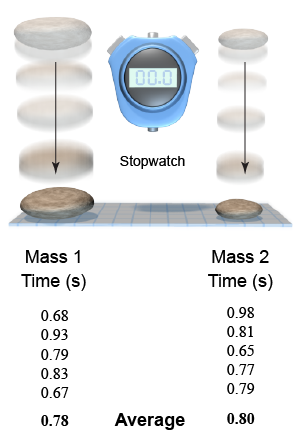|
It is easily observed that a stone falls faster than a feather. A common (and incorrect) explanation is that heavier objects fall faster than lighter objects. The difference is actually caused by air resistance, but we learned this only by critique of the older hypothesis. In science, critique means to question and test scientific knowledge by logic, experiment, and observation. 
|
A student decides to test the explanation that heavier objects fall faster by dropping two stones of different weight. The time to fall is measured with a stopwatch (see the table at right). On average, the heavier stone is 0.02 s faster than the lighter stone. Does this measured, empirical evidence support the explanation? 
| 
|
The answer is no because all measurements always have some uncertainty, or error. In the context of measurement, error is not a mistake. Error is the unavoidable difference between a measurement and the true value of the quantity being measured. Errors can be small but are never zero. To evaluate any experimental result one must critique the evidence by asking the following: Is the observed “effect” significantly bigger than the uncertainty in the measurement? 
|

| The average of many identical measurements is a better estimate for the “true” value. This is the case because, with enough independent measurements, random errors should cancel out. Taking the average, however, has another purpose! The distribution of values around the average allows you to estimate that the uncertainty, or error, in the measurement is approximately ±0.05 s. Without knowing the uncertainty you cannot know whether any differences you observe are real or result from random measurement errors. |

|
Looking critically at this student’s evidence, we see that the difference between the heavier and lighter rocks is less than the uncertainty. Therefore, the difference is insignificant. The two falling times are identical within the precision of the experiment. This experiment does not support the explanation because the experiment finds no significant difference between the heavy stone and the lighter stone. All empirical evidence must be evaluated with respect to uncertainties in measurement before any conclusion can be made. 
|
| |
|

